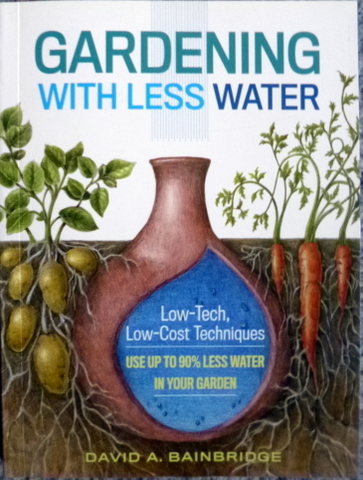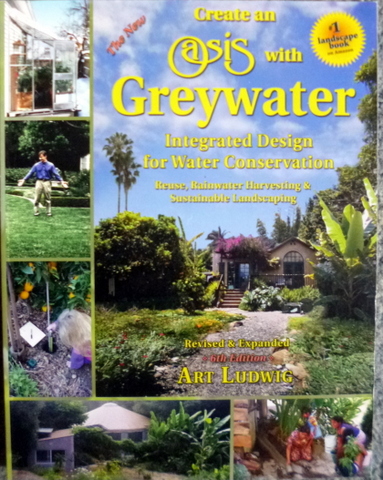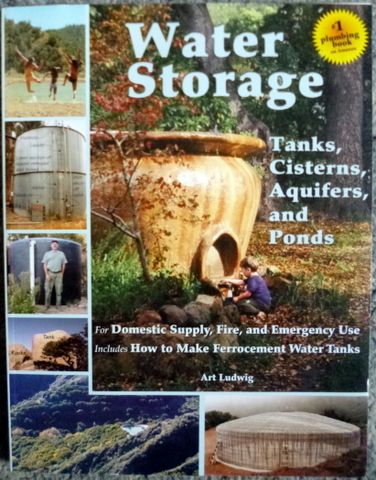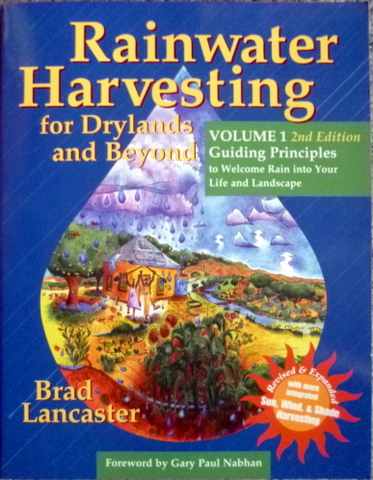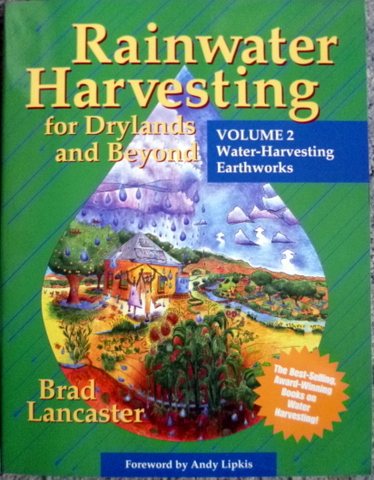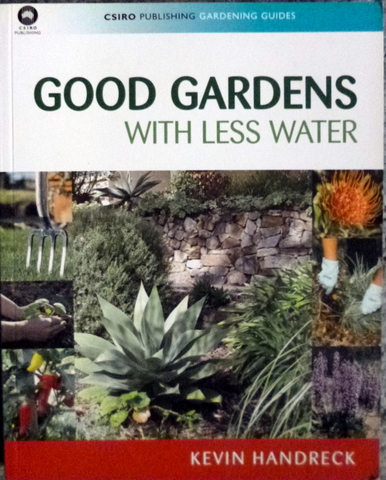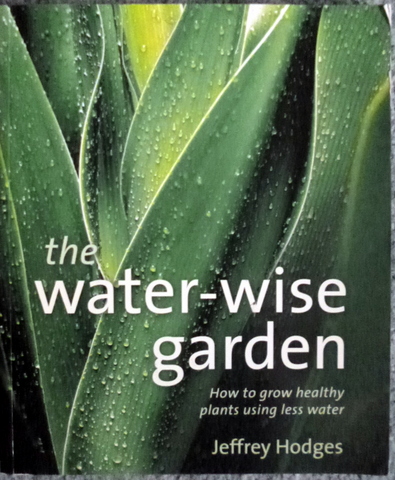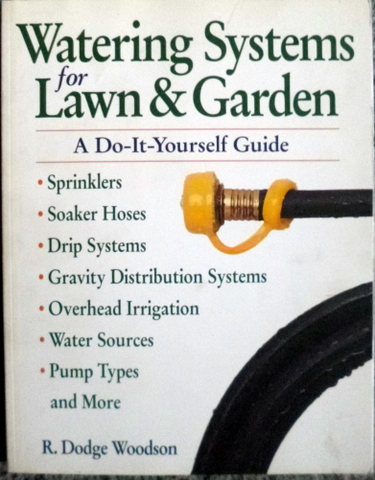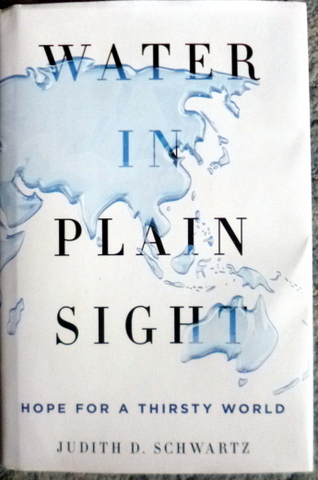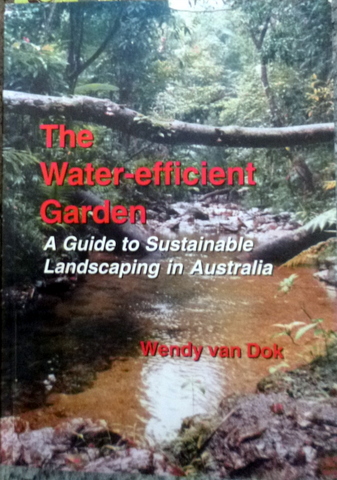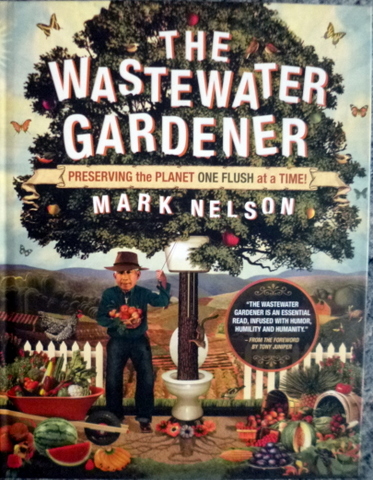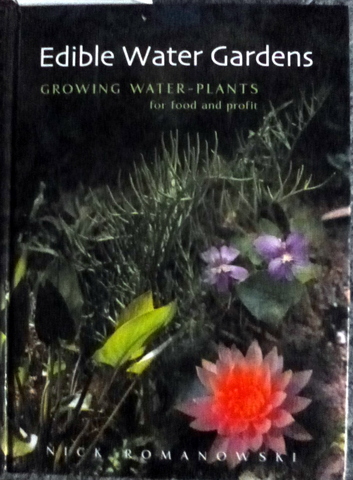Over the years I seem to accumulate more and more books on the subjects I am interested in, so it is time to add in more water related books to the library.
Gardening with Less Water – David A. Bainbridge – Storey Publishing (US) 2015 ISBN 978 1 61212 582 4 – This is not a big book but it is chock full of techniques we all should be using. Part 1 of the book covers the techniques: buried clay pots, porous capsules, deep pipes, wicks, porous hose, buried clay pipe and tree shelters. Part 2 is about taking it to the next level and covers water-wise gardening tips, rainwater harvesting, landscaping for water catchment and developing a plan. If you are concerned about the water used in your garden, you need this book in your library. The book has lots of colour sketches and colour photos.
Create an Oasis with Greywater (6th Edition) – Art Ludwig – Oasis Design (US) 2015 ISBN 978 0 9643433 3 7 – This book describes how to choose, build and use 20 types of residential greywater re-use system in just about any context. It explains how you can put together a simple greywater system in an afternoon. It also talks about how you can integrate it with water efficiency, rainwater use and food production. It does reflect the US experience so some approaches may not work in Aus and some products may not be available. Obviously, any discussion about laws etc. should be taken with a grain of salt! Lots of black and white photos and line drawings.
Water Storage – Art Ludwig – Oasis Design (US) 2011 ISBN 978 0 9643433 6 8 – This book describes how to store water for the home, farm and small community. The book talks about general system design principles, avoiding common mistakes, different kinds of storage and working out how much water you need. Also covered is how to work out the best material for your storage container, plumbing details and real life examples of storage designs. As for the previous book this is US based. Lots of black and white photos and line drawings.
Rainwater Harvesting for Drylands and Beyond: Volume 1 – Guiding Principles – Brad Lancaster – Rainsource Press (US) 2013 ISBN 978 0 9772464 3 4 – While the drylands referred to in the title are mainly the ones in the US there are lots of ideas here which will work well in Aus. The intro talks about the author’s journey around water, the first chapter talks about rainwater principles and ethics. The second chapter talks about assessing your sites water resources and chapter 3 is an overview of harvesting water with earthworks. Chapter 4 covers integrated design, bringing in the effect of the sun on design, but chapter 5 – An integrated urban home and neighbourhood retrofit, I found to be most useful. Lots of B&W photos and line drawings.
Rainwater Harvesting for Drylands and Beyond: Volume 2 – Water Harvesting Earthworks – Brad Lancaster – Rainsource Press (US) 2013 ISBN 978 0 9772464 1 0 – The introduction covers how earthworks are defined, their advantages and a success stories. Chapter 2 covers the process you can use to assess your site and the next 10 chapters cover various water harvesting techniques including berms, French drains, terraces, infiltration basins, reducing hardscaping, swales, check dams and vegetation. The last chapter covers greywater and there is a motivational epilogue. While the title may not lead you to think there is much here for the suburban landscape it is a good book for the rural and suburban experience. Lots of B&W photos and line drawings.
Good Gardens with Less Water – Kevin Handreck – CSIRO (AUS) 2008 ISBN 978 0 643094 70 3 – The book covers how to improve soil structure to maximise water retention, selecting drought tolerant natives and exotics, working out how much water to apply to different plants, rainwater harvesting and use and how to avoid problems with greywater in the garden. Good info but not much on the productive garden and not particularly organic. Lots of colour photos.
The Water-wise Garden – Jeffrey Hodges – Viking (AUS) 2008 ISBN 978 0 670 07109 8 – This one IS nicely organic in approach! The book gives some theory around how plant use water and what effect this should have on watering practices, creating “water use” zones and improving the water-holding content of the soil. There are also sections on fertilising and dealing with pests and diseases using organic methods and the capture and use of rainwater and greywater. The book has a small number of colour photos and a few line drawings.
Watering Systems for Lawn & Garden – R. Dodge Woodson – Storey Publishing (US) 1996 ISBN 978 0 88266906 9 – The introduction talks about options for plant watering and the next chapter asks asks the question, “is irrigation practical?”. Freshwater sources (including spear point well) are discussed followed by recycled water for irrigation. Following chapters cover moving water by pump and by gravity, surface, overhead and buried irrigation options and irrigation fitting and getting your system operational. As usual, the experience is US and so laws mentioned will not apply and not all products will be available. Lots of line drawings.
Water in Plain Sight – Judith D. Schwartz – St Martin’s Press (US) 2016 ISBN 978 1 250 06991 7 – This is not a “how to” book, it is more a “big picture” book going through how our landscapes are drying and why, in areas so diverse as southern Africa, the Amazon basin and outback Australia. It is also a wonderful book about how not only does climate change affect our water supplies, but how our water supply can also drive climate change. Lots about the problems but also wonderful examples of what people are doing to fix the problems. No illustrations.
The Water Efficient Garden – Wendy Van Dok – Water Efficient Gardenscapes (AUS) 2002 ISBN 0957765525 – This is another small book with lots of great ideas. It starts off (after an intro which asserts we have enough water, but it is where the water is, geographically) with how to reduce you demand in the house and garden including working out a water budget. The next section talks about techniques for storing water in the soil, followed by one on how to supplement or replace tap water, with rainwater tanks etc. The final sections cover how to irrigate efficiently and how to minimise water loss. A great little book! Mostly B&W photos and line drawings with a few colour photos thrown in to confuse you.
The Wastewater Gardener – Mark Nelson – Synergetic Press (US) 2014 ISBN 978 090779152 2 – Again, this is not so much a “how to” as a “what I did” type of book! This guy does seem to know all there is to know about constructed wetlands and has worked putting them in and running them all over the world, including northern Australia. He was involved in the Biosphere 2 experiment and for 2 years managed their sewage treatment wetlands. He calls them wastewater gardens and has developed them in Algeria, Belize, the Bahamas, Indonesia, the Philippines, Spain – all over the world and this book is a distillation of his experiences. Lots of B&W photos and some colour photos.
Edible Water Gardens – Nick Romanowski – Hyland House (AUS) 2007 ISBN 978 1864471021 – Chapter 1 covers the generalities of growing aquatic and water edge plants, including notes about water, and water quality, soil, dissolved gases, fertilisers, propagation, harvest methods and vermin, disease and weeds. The other chapters are divided up into the types of growing environments and which plants suit them, such as floating plants, plants for shallower areas, plants for waterlogged soils and other useful and profitable wetland plants. In each chapter are a series of monologues on each suitable plant giving some history, how they are classified, a description, how they are grown and how they are used. The book has lots of colour photos and some line drawings.



